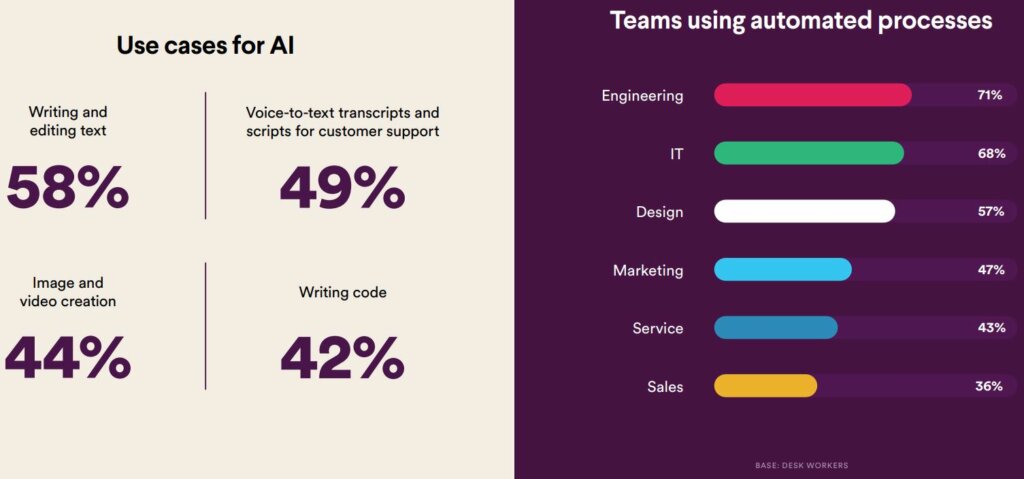
How can organizations measure employee work productivity?
Are AI productivity tools really improving the workforce?
AI productivity tools in the workplace are seeing increasing implementation in recent times. More companies are investing in AI productivity tools to not only improve efficiency at work but also enable their employees to have a better work-life balance.
According to Slack’s State of Work report, AI and automation hold the keys to employee productivity. However, many companies have not adopted these tools yet. The report states that almost one in two employees in Singapore felt that their company has not incorporated AI tools to support their productivity. One-third also say that their team has not used automation to make their work processes more efficient.
Despite this, 35% of companies in Singapore are using AI to help improve productivity. In fact, Singapore is second in the world in terms of AI adoption at work, globally. India ranks first with a total adoption of 75%, while Australia is ranked sixth with 21% AI adoption. The report surveyed 1,341 desk workers in Singapore.
What’s more interesting is that despite the high adoption of AI productivity tools at work, 44% of workers still believe they spend too much time on meetings and emails. Another interesting finding is that an average of just 64% of workers’ time is spent on “real work” while 36% of their time is spent on “performative work”.

Derek Laney, Slack Technology Evangelist, in APAC for Salesforce
“We’ve already seen hints of the incredible productivity that generative AI (trained on public data) can unlock at work. The real power of this technology will be realized when companies’ AI tools can also analyze and act on the valuable knowledge they’ve curated internally about their own
customers, people and projects,” stated Lidiane Jones, CEO of Slack in the report.
Real work vs Performative work
One of the biggest challenges most organizations around the world face today is measuring productivity at work. Generally, an organization measures productivity by the amount of work completed by an employee in their workplace. This was also one of the reasons why most companies began requesting their employees to return to work in the office.
In reality, workplace productivity can’t be determined just by the number of hours one spends at work. In Singapore for example, employees spend about 36% of their working time grappling with business formalities such as meetings and emails, which they feel don’t contribute to company and team goals but are done to appear productive. 29% of Singapore executives are also tracking activity metrics (e.g. hours worked, emails sent) among their employees, but only 15% of employees believe doing so helps their productivity.
An interesting statistic from the report showed that 54% of Singaporeans make an effort to keep their status green or active online, even if they’re not working. This phenomenon is referred to as performative work or productivity theatre which is not desirable behavior but occurs because of the way employee work is measured.
“The research shows us that employees, to be happy and engaged at work, want to be productive. And they find these AI tools are able to make them productive, as long as they’re being measured based on their productivity, as in their outputs, and not their visible activity, their inputs. This means they can get the value of this improved productivity, such as improved compensation or just get time back in their lives.
I think, more so than any other market in Singapore, that’s a real concern. We see that Singaporeans are more likely to be checking their emails on weekends and more likely attending to work after hours. There is a culture of always-on because I think Singaporeans work across so many time zones and that they feel like they always need to be present. It’s a real challenge,” explained Derek Laney, Slack Technology Evangelist, in APAC for Salesforce.

Tweet on AI being used for productivity.
Implementation of AI productivity tools
AI and automation capabilities have the potential to streamline and optimize repetitive, time-consuming tasks, allowing Singapore employees to focus on higher-value, strategic work:
- Those who have adopted AI at their company are 63% more likely to report higher levels of productivity than those who have not adopted
- Most (81%) employees say that being able to automate routine tasks, such as getting expense report approvals, would improve their productivity.
- Those who use automation at work estimate saving an average of 3.6 hours a week – this equates to at minimum one working month a year* given back to each employee to focus on meaningful
However, 53% of employees in Singapore say their company has not incorporated AI tools to support their productivity. And 32% say that their team has not created automation to make their work processes easier or more efficient.
The majority (82%) of employees in Singapore say that feeling happy and engaged with their organization would improve their productivity. Employers need to also prioritize wellness, as 58% of employees in Singapore say that they feel pressure to respond to messages quickly, even if they’re sent after standard working hours.
“The reason why Singaporean workers are one of the highest adopters of automation and AI is because they are so hard working and want to produce the output. I hope that if we can measure workers differently, they can get their time back. What’s concerning is that now, some are using AI to pretend like they’re working when they’re not working, because they feel like that’s required. This behavior is not useful,” added Laney.
In the age of hybrid work, employees in Singapore are looking for flexibility and an environment that fosters collaboration and inclusivity:
- More than half (54%) say that flexible work schedules are one of the best ways for their employer to support their
- Employees say flexible location (43%), unique workplace benefits, such as providing lunch or recreational activities (32%), and making improvements to the workplace, such as having more meeting rooms and quiet areas (29%), also enhance
- 41% of employees in Singapore cited coordinating or collaborating with other teams as a key challenge faced by their immediate In fact, a majority (82%) say that having the right technology to collaborate from anywhere (share knowledge, drive projects forward, etc.) would improve their productivity.
However, only a few executives in Singapore are using modern strategies to improve how employees work with each other – wherever they are:
- Just 21% of Singapore executives are making changes to the physical office, such as quiet libraries, collaboration spaces, and larger social
- Only 18% are encouraging asynchronous work, for example when sharing status
- 44% of employees in Singapore cite spending too much time in meetings as a top productivity challenge. In fact, employees say that 44% of their meetings could be eliminated with no real adverse

How AI is being used to improve productivity at work. (Source – Slack)
Productivity measurement
Highlighting companies in Singapore like ShopBack, Laney mentioned their methodology of working in the open working as a transparent company means everyone uses collaborative platforms like Slack. Work is completed in shared channels so that productivity can be seen and easily measured.
“This type of transparency creates a culture of trust. For ShopBack, it saves them 20 to 45 minutes a day, just converting some of those unnecessary meetings that were largely performative into sort of different digital methods in Slack. That’s good as it gives time back to employees to reinvest in what’s useful for them, whether that’s time with their family, or whether that’s more productive work,” said Laney.
Managers play a key role in shaping work culture and need to be armed with people development skills, tools to drive efficiency and manage teams, and team wellness support. However, they face challenges in creating a healthy and productive environment:
- 42% of people managers in Singapore cite helping their team stay motivated as a top This is compounded by the fact that one-third (34%) of employees say that staying aligned on overall company goals and direction is a hurdle to productivity.
- Also, more than a third (39%) of people managers identify spending too much time on tasks like meetings and emails, and helping their team stay motivated (42%), as additional challenges they
This is also where tools like Slack GPT can make a difference. Slack GPT aims to provide intelligence across automation, shared knowledge, and conversations in Slack. More importantly, the AI can be tailored to a company’s specific requirements, whether they want to integrate a preferred language model, create their own AI-driven no-code workflows, or seamlessly incorporate AI into the Slack experience.
“My hope for the future is work becomes not only more productive but more enjoyable. The mission of Slack is to make work more productive, but also more pleasant. We find in the research that nine in 10 workers link happiness to their productivity. AI is not about replacing humans with a robotic alternative. It’s about finding ways to take the things that we don’t like to do to free up time for us to work on the things that were most useful so that we gain pleasure from work,” concluded Laney.
READ MORE
- 3 Steps to Successfully Automate Copilot for Microsoft 365 Implementation
- Trustworthy AI – the Promise of Enterprise-Friendly Generative Machine Learning with Dell and NVIDIA
- Strategies for Democratizing GenAI
- The criticality of endpoint management in cybersecurity and operations
- Ethical AI: The renewed importance of safeguarding data and customer privacy in Generative AI applications


